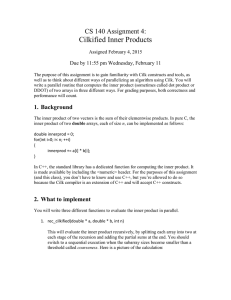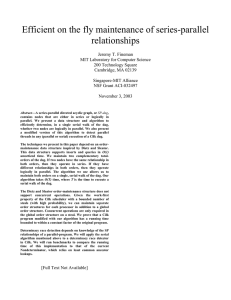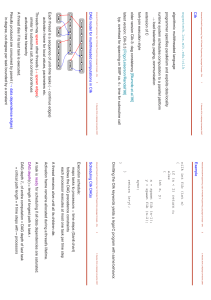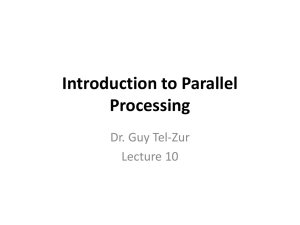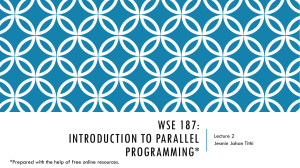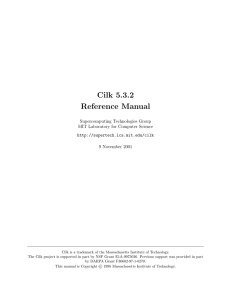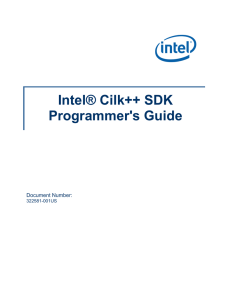Performance Engineering of Software Systems
advertisement
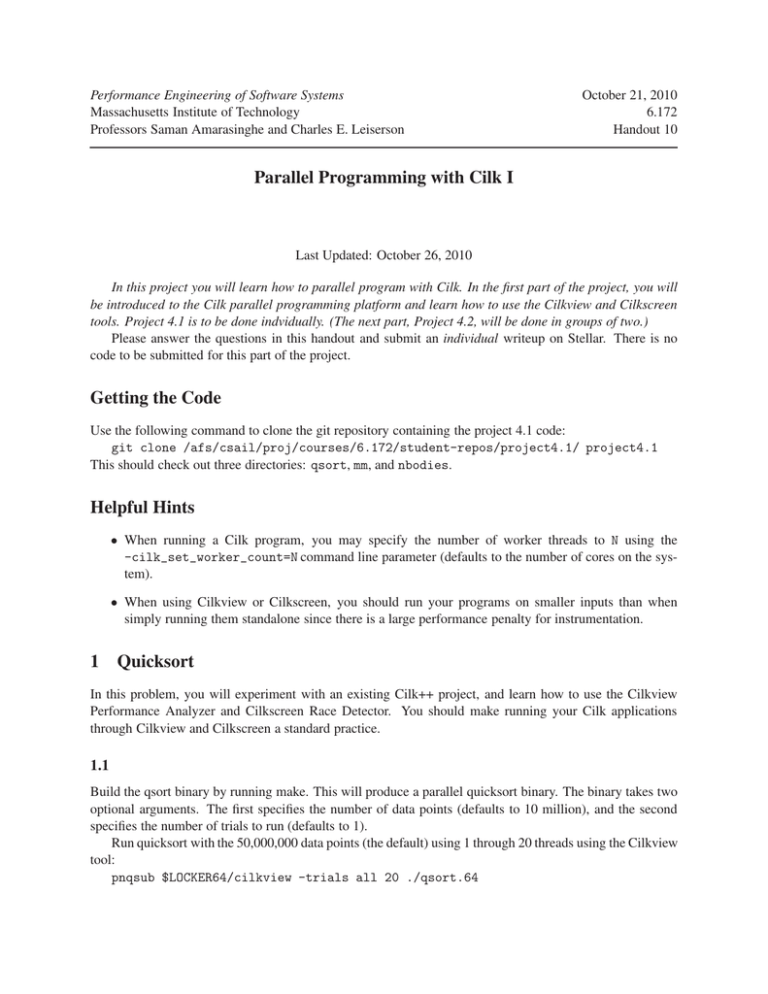
Performance Engineering of Software Systems
Massachusetts Institute of Technology
Professors Saman Amarasinghe and Charles E. Leiserson
October 21, 2010
6.172
Handout 10
Parallel Programming with Cilk I
Last Updated: October 26, 2010
In this project you will learn how to parallel program with Cilk. In the first part of the project, you will
be introduced to the Cilk parallel programming platform and learn how to use the Cilkview and Cilkscreen
tools. Project 4.1 is to be done indvidually. (The next part, Project 4.2, will be done in groups of two.)
Please answer the questions in this handout and submit an individual writeup on Stellar. There is no
code to be submitted for this part of the project.
Getting the Code
Use the following command to clone the git repository containing the project 4.1 code:
git clone /afs/csail/proj/courses/6.172/student-repos/project4.1/ project4.1
This should check out three directories: qsort, mm, and nbodies.
Helpful Hints
• When running a Cilk program, you may specify the number of worker threads to N using the
-cilk_set_worker_count=N command line parameter (defaults to the number of cores on the sys­
tem).
• When using Cilkview or Cilkscreen, you should run your programs on smaller inputs than when
simply running them standalone since there is a large performance penalty for instrumentation.
1 Quicksort
In this problem, you will experiment with an existing Cilk++ project, and learn how to use the Cilkview
Performance Analyzer and Cilkscreen Race Detector. You should make running your Cilk applications
through Cilkview and Cilkscreen a standard practice.
1.1
Build the qsort binary by running make. This will produce a parallel quicksort binary. The binary takes two
optional arguments. The first specifies the number of data points (defaults to 10 million), and the second
specifies the number of trials to run (defaults to 1).
Run quicksort with the 50,000,000 data points (the default) using 1 through 20 threads using the Cilkview
tool:
pnqsub $LOCKER64/cilkview -trials all 20 ./qsort.64
Handout 10: Parallel Programming with Cilk I
2
What are the execution times? What happens when you run qsort with more threads than there are proces­
sors on the cloud machines (12)?
When running Cilkview directly on the cloud machines (rather than through PNQ), a speedup graph is
automatically displayed with parallelism bounds and measured speedup. You may try this with:
cilkview -trials all ./qsort.64
(You must have an X server running on your local machine and have X11 forwarding enabled on your SSH
connection to view the graph on your local machine.)
When submitting CilkView jobs over the PNQ batch system, the results are saved to a file, so you
can load the results into gnuplot manually to view the results. To do this, run gnuplot and enter load
"qsort.plt". (Again, X must be configured properly.)
1.2
Uncomment the following line near the top of the file to introduce a race condition in the parallel code:
#define INTENTIONAL_RACE
Look at the code enabled by this change and explain how the race could cause quicksort to fail to sort the
array of integers.
1.3
Run qsort through Cilkscreen using the following command:
pnqsub $LOCKER64/cilkscreen ./qsort.64 10000
or
cilkscreen ./qsort.64 10000
Is Cilkscreen able to detect the race? Obtain the approximate failure rate when sorting 10000 integers with
12 threads. Run qsort.64 with at least 1000 trials to obtain the failure rate.
2 Matrix Multiplication
In this part, you will write a multithreaded program in Cilk++ to implement matrix multiplication. One of the
goals of this assignment is for you to get a feeling of how work, span, and parallelism affect performance.
First, you will parallelize a program that performs matrix multiplication using three nested loops. Then,
you will write a serial program to perform matrix multiplication by divide-and-conquer and parallelize it by
inserting Cilk keywords.
For those of you who have not looked at matrix multiplication in a little while, the problem is to compute
the matrix product
C = AB ,
where C, A, and B are n × n matrices. Each element ci j of the product C can be computed by multiplying
each element aik of row i in A by the corresponding element bk j in column j in B, and then summing the
results, that is,
ci j =
n
�
aik bk j .
k=1
For more information on matrix multiplication, please see http://en.wikipedia.org/wiki/Matrix_
multiplication#Ordinary_matrix_product.
Handout 10: Parallel Programming with Cilk I
3
The nested-loop and divide-and-conquer versions of these programs can be adapted to work with arbi­
trary rectangular matrices. To simplify the interface, however, we limit ourselves to n × n square matrices.
Matrix multiplication using loop parallelism
The file mm_loops.cilk contains two copies of a Θ(n3 )-work matrix multiplication algorithm using a
triply nested loop. The first copy (mm_loop_serial) is the control for verifying your results — leave it un­
changed. The second copy (mm_loop_parallel) is the one that you will parallelize. This file also contains
a test program that verifies the results of your parallel implementation and also provides infrastructure for
timing and measuring parallelism.
2.1
Compile mm_loops with optimization, and verify that it operates correctly. Supply the --verify commandline option to force running all tests.
Now parallelize the mm_loop_parallel function by changing the outermost for loop into a cilk_for
loop. Verify correct results with the --verify option. Run Cilkview on your program and report the
theoretical and actual speedup. Do not use the --verify option when running Cilkview.
2.2
Change the outermost cilk_for back into a serial for loop and change the middle for loop into a
cilk_for loop. Repeat the test with the --verify option, and then report the results from Cilkview.
Did any results change? Try making both loops parallel. Which of these combinations produces the best
results?
Matrix multiplication by divide-and-conquer
Divide-and-conquer algorithms often run faster than looping algorithms, because they exploit the micropro­
cessor cache hierarchy more effectively. This section asks you to write a divide-and-conquer implementation
of matrix multiplication. You will find the source code for the incomplete program in mm_recursive.cilk.
The program contains two implementations of matrix multiplication. The mm_loop_serial function is the
same as before and is provided for verification and timing comparisons. The mm_recursive_parallel
function is the skeleton of a divide-and-conquer implementation.
Your recursive implementation will be based on the identity
�
A11 A12
A21 A22
��
B11 B12
B21 B22
�
=
�
A11 · B11 + A12 · B21 A11 · B12 + A12 · B22
A21 · B11 + A22 · B21 A21 · B12 + A22 · B22
�
,
where A11 , A12 , etc., are submatrices of A. In other words, matrix multiplication can be performed by sub­
dividing each matrix into four parts, then treating each part as a single element and (recursively) performing
matrix multiplication on these partitioned matrices. (The number of columns in A11 must match the number
of rows in B11 , and so forth.) Although the algorithm operates recursively, its work is still Θ(n3 ), the same
as the straightforward algorithm that employs triply nested loops.
Handout 10: Parallel Programming with Cilk I
4
2.3
Compile mm_recursive, and verify that it compiles but fails to run successfully when using the --verify
command-line argument. The failure is caused by the fact that the mm_recursive_parallel has not been
fully implemented yet.
2.4
In the file mm_recursive.cilk, fill in code in the mm_internal function to implement the divide-and­
conquer algorithm. The error-prone task of subdividing the matrices into four parts has been done for
you. All you need to do is to fill in the recursive calls (eight in total – one for each of the eight matrix­
multiplications in the algorithm). Compile and run your new mm_recursive program and verify that it runs
successfully.
2.5
Which recursive calls to mm_internal may be legally executed in parallel with one another and why?
Make your recursive function parallel by adding the cilk_spawn keyword in front of some of the
recursive calls. You will need to add calls to cilk_sync as well in order to separate recursive calls that
would otherwise cause a data race and to ensure that all of the work is complete before returning from the
function.
Compile and run your new mm_recursive program. Verify that it is correct and report the results given
by Cilkview. For large matrices, how does the performance of the recursive algorithm compare with the
nested-loops algorithm on a single processor?
2.6
Uncomment the line near the top of the program that reads:
#define USE_LOOPS_FOR_SMALL_MATRICES”.
This change causes the algorithm to change from divide-and-conquer recursion to a triply nested loop for
small matrices. How does this change impact performance? How does the performance of this new version
compare to the previous versions?
3 N-Bodies Simulation
In this part, you will modify a program that simulates a set of planetary bodies drifting in space in the
neighborhood of a single, massive “sun.” Each body bi (including the sun) has a mass mi and an initial
velocity vi , and is attracted to another body b j of mass m j by a force fi j , which obeys the formula for
gravitational attraction,
mi m j
fi j = G 2 ,
r
where G is the gravitational constant, and r is the distance between the bodies. The force on bi is directional
and pulls bi towards b j . The total force fi on body bi is the vector sum of the forces fi j for all j �= i.
The N-bodies simulation program begins by creating N bodies (the number N is specified on the com­
mand line) with randomly-selected masses in a random distribution around the sun. All of the bodies are
Handout 10: Parallel Programming with Cilk I
5
given initial velocities such that the entire system appears to have a clockwise spin. A two-dimensional
coordinate system is used for simplicity.
The simulation progresses by computing successive positions of each of the N bodies for successive
moments in time using a two-pass algorithm. The first pass computes the force on each body as the sum of
the forces exerted on it by all of the other bodies in the system. The second pass adjusts the velocity of each
body according to the force computed in the first pass and moves the body’s position according to its average
velocity during that quantum of time. Every few time quanta, a snapshot of the entire system is rendered as a
picture in png format. You can view the result as a short movie using the provided JavaScript-powered web
page. After running the nbodies binary, type make publish to copy the nbodies.html file and your PNG
outputs to your CSAIL webpage. Then visit http://people.csail.mit.edu/<username>/nbodies/
to view your movie.
Note that the execution times for these programs can be fairly long. Since Cilkview runs the program
at least 5 times, expect to wait several minutes for a Cilkview run to complete. You may wish to reduce the
number of images produced to save time. If you choose to do so, do not reduce the number of bodies in the
simulation, or you will reduce the total parallelism in your program.
When running Cilkscreen to detect races, you can and should reduce the number of bodies and images
produced to a bare minimum (e.g. 10 bodies and 2 images). Note that if you produce fewer images the
visualization will be truncated, and the web page may display some parts of the previous run if there were
leftover PNG files in your directory.
Burdened parallelism in the N-bodies simulation
The file nbodies_loops.cilk implements the n-body simulation. The calculate_forces function uses
a pair of nested loops to compute the forces for every pair of bodies. The update_positions function uses
a single loop to update the position of each body.
The nbodies binary accepts two arguments: the first is the number of bodies in the simulation (defaults
to 800), and the second is the number of PNG frames to produce (defaults to 100). The number of simulation
steps computed between frames is 40. All of these defaults and constants may be changed by modifying the
#defines at the top of the common.h file.
3.1
Compile nbodies_loops with optimization, and run it with the default number of bodies (800). View the
simulation in a web browser by running make publish and visiting:
http://people.csail.mit.edu/<username>/nbodies/.
Click the “Start” button to view the movie. (JavaScript must be enabled.) Parallelize the program by
changing the loop in update_positions and the inner loop in calculate_forces to cilk_for. Run the
program in Cilkview and report the results.
3.2
Insert the line “#pragma cilk_grainsize=1” just before the cilk_for in calculate_forces. Run the
program in Cilkview and compare its performance with the previous run. Explain these results.
Handout 10: Parallel Programming with Cilk I
6
3.3
Unlike in the matrix-multiplication example, you cannot parallelize the outer loop in calculate_forces,
because doing so would cause multiple iterations to race on updating a single body’s forces. (Try it in
Cilkscreen if you want.) However, you can invert the inner and outer loops of your current code so that the
cilk_for loop over i is on the outside. Try it, and report your results from Cilkview. (You should remove
the grainsize pragma.) Which version is faster and why?
Resolving races with locks
The formula for computing the gravitational force between two bodies bi and b j is symmetrical such that
f ji = − fi j (i.e., the magnitude of the force on both bodies is the same, but the direction is reversed.) Our
current implementation of the N-bodies simulation, however, computes each force twice: once when com­
puting the force that b j applies to bi , and again when computing the force that bi applies to b j . We can halve
the total number of iterations in calculate_forces if we take advantage of this fact and compute the force
only once for each pair of bodies.
In the file nbodies_symmetric.cilk, we have modified the inner loop in calculate_forces to
avoid calculating forces that have already been computed in an earlier iteration (according to the serial
ordering). When computing a force fi j and adding it to fi , we also compute the inverse force ji and add it
to f j . Unfortunately, this simple optimization has its problems, as we shall see.
3.4
In nbodies_symmetric, parallelize update_positions and the outer (i) loop of calculate_forces.
Compile nbodies_symmetric and run it with a command-line argument of 800. Did we see the expected
speedup of 2 versus the (parallel) version of nbodies_loops? Run the program again in the Cilkscreen
race detector, but shorten the run time by using a command-line argument of 10 instead of 800 (and you
shouldn’t have to use PNQ for this). Where did the races come from, and why weren’t they visible in the
initial run?
3.5
One way to fix the race is to use a mutex (mutual exclusion) lock to mediate concurrent access to each
object. Add a member mtx, of type cilk::mutex to the Body struct. In add_forces, insert the statement
“b->mtx.lock();” before updating b->xf and b->yf and insert “b->mtx.unlock();” after updating
them. Run the program with Cilkview (using the original command-line argument of 800) and report the
theoretical and actual speedup.
Solving races without locks
For sufficiently large data sets, the previous solution should produce little lock contention. Nevertheless,
both locks and atomic instructions are expensive, even in the absence of contention, because they interrupt
the CPUs’ pipelines and force serializing operations that the CPU would have internally performed in par­
allel. It would be ideal if we could parallelize the N-bodies problem without introducing data races at all,
thus eliminating the need for locks or atomic instructions.
Handout 10: Parallel Programming with Cilk I
7
One such solution, due to Matteo Frigo, uses divide-and-conquer parallelism in a way that ensures that
no two parallel strands attempt to modify the same body. The algorithm, with the Cilk keywords removed,
is implemented in the file nbodies_nolocks.cilk.
Figure 1 shows the core of the program. The lines labeled [A] (Lines 44–45) can be executed in parallel
with each other. Similarly, the lines labeled [B] (lines 16–17) can be executed in parallel with each other, and
the lines labeled [C] (lines 18–19) can be executed in parallel with each other. This program is not meant to
be obvious. Let’s explore what it does.
The serial program is equivalent to calling add_force(&bodies[i], fx, fy); and
add_force(&bodies[j], fx, fy); for all 0 ≤ i ≤ j < N. Another way to look at it is that a plot of the
points (i, j) such that 0 ≤ i ≤ j < N comprise the shaded area shown in Figure 2.
Procedure triangle traverses this triangle in parallel, and in fact it is a little bit more general, because
it traverses any triangle of the form n0 ≤ i ≤ j < n1. Initially, we set n0 = 0 and n1 = N in cilk_main.
Procedure triangle works by recursively partitioning the triangle. If the triangle consists of only one
point, then it visits the point (n0, n0) directly. Otherwise, the procedure cuts the triangle into one rectangle
and two triangles, as shown in Figure 3.
The two smaller triangles can be executed in parallel, because one consists only of points (i, j) such
that i < nm and j < nm, and the other consists only of points (i, j) such that i ≥ nm and j ≥ nm. Thus,
the two triangles update nonoverlapping regions of the force array, and thus they do not race with each
other. However, the rectangle races with both triangles, and thus we need a cilk_sync statement before
processing the rectangle.
To traverse a rectangle we use procedure rect, which also works recursively. Specifically, if the rectan­
gle is large enough, the procedure cuts the rectangle i0 ≤ i < i1 , j0 ≤ j < j1 , into four smaller subrectangles,
as shown in Figure 4.
The amazing thing is that the two black subrectangles can be traversed in parallel with each other without
races. Similarly, the two gray subrectangles can be traversed in parallel with each other without races. Since
the black and gray subrectangles race with each other, however, we must use a cilk_sync statement after
processing the first pair of subrectangles.
To see why there are no races between the two black subrectangles (the same argument applies to the
gray) observe that the i-ranges of the two subrectangles do not overlap, because one is smaller than im and
the other is larger. For the same reason, neither do the j-ranges overlap. In order for races not to occur,
however, we must also prove that the i-range of one subrectangle does not overlap with the j-range of the
other, because we are updating both bi and bj. This property holds because when triangle calls rect
initially, the i-range is n0 ≤ i < nm, whereas the j-range is nm ≤ j < n1, so the two ranges never overlap.
This algorithm partitions the original data into smaller and smaller subsets. Thus, in addition to avoid­
ing races and locks, the algorithm exploits cache locality in a way similar to that of the recursive matrixmultiplication example.
3.6
The file nbodies_norace.cilk implements the divide-and-conquer algorithm as a serial program. Notice
that the rect routine coarsens the recursion and reverts to a looping implementation when the rectangle is
sufficiently small (one of the sides has length at most THRESHOLD). The triangle routine is not similarly
coarsened, however. Explain why coarsening triangle would not improve performance significantly for
large problem sizes.
Handout 10: Parallel Programming with Cilk I
1
2
3
4
5
6
7
8
9
10
11
12
13
14
15
16
17
18
19
20
21
22
23
24
25
26
27
28
29
30
31
32
33
34
35
36
37
38
39
40
41
42
43
44
45
46
47
48
49
50
51
52
53
54
55
// update the force v e c t o r s on bi and bj e x e r t e d on each by the
other .
void a d d _ f o r c e ( Body * b , double fx , double fy )
{
b - > xf += fx ;
b - > yf += fy ;
}
/* t r a v e r s e the r e c t a n g l e i0 <= i < i1 , j0 <= j < j1 */
void rect ( int i0 , int i1 , int j0 , int j1 , Body * bodies )
{
int di = i1 - i0 , dj = j1 - j0 ;
const int T H R E S H O L D = 16;
if ( di > T H R E S H O L D && dj > T H R E S H O L D ) {
int im = i0 + di / 2;
int jm = j0 + dj / 2;
rect ( i0 , im , j0 , jm , bodies ) ; // [ B ]
rect ( im , i1 , jm , j1 , bodies ) ; // [ B ]
rect ( i0 , im , jm , j1 , bodies ) ; // [ C ]
rect ( im , i1 , j0 , jm , bodies ) ; // [ C ]
}
else {
for ( int i = i0 ; i < i1 ; ++ i ) {
for ( int j = j0 ; j < j1 ; ++ j ) {
// update the force vector on bodies [ i ] e x e r t e d by
bodies [ j ]
// and , s y m m e t r icall y , the force vector on bodies [ j
] e x e r t e d
// by bodies [ i ].
if ( i == j ) c o n t i n u e;
double fx , fy ;
c a l c u l a t e _ f o r c e (& fx , & fy , bodies [ i ] , bodies [ j ]) ;
a d d _ f o r c e (& bodies [ i ] , fx , fy ) ;
a d d _ f o r c e (& bodies [ j ] , -fx , - fy ) ;
}
}
}
}
// t r a v e r s e the t r i a n g l e n0 <= i <= j < n1
void t r i a n g l e( int n0 , int n1 , Body * bodies )
{
int dn = n1 - n0 ;
if ( dn > 1) {
int nm = n0 + dn / 2;
t r i a n g l e( n0 , nm , bodies ) ; // [ A ]
t r i a n g l e( nm , n1 , bodies ) ; // [ A ]
rect ( n0 , nm , nm , n1 , bodies ) ;
}
else if ( dn == 1) {
// Do n o t h i n g. A single body has no i n t e r a c t i o n with
itself .
}
}
void c a l c u l a t e _ f o r c e s ( int nbodies , Body * bodies ) {
t r i a n g l e (0 , nbodies , bodies ) ;
}
Figure 1: A lock-free code for N-bodies.
8
Handout 10: Parallel Programming with Cilk I
9
i
N
N
j
Figure 2: Traversing the space, 0 ≤ i ≤ j < N
i
nm
n0
n1 j
Figure 3: Cutting a triangle into two smaller triangles and a rectangle
i
i1
im
i0
j0
jm
j1
Figure 4: Dividing a rectangle into four
j
Handout 10: Parallel Programming with Cilk I
10
3.7
Add cilk_spawn and cilk_sync statements to implement the divide-and-conquer parallel algorithm.
Briefly describe the changes you made. Also add a cilk_for to parallelize the update_positions func­
tion.
3.8
Confirm that the program is race free by running it in the race detector (use only 10 bodies to avoid long
run times). Run the program in Cilkview and report the results. Compare the performance to runs of earlier
versions of the program.
MIT OpenCourseWare
http://ocw.mit.edu
6.172 Performance Engineering of Software Systems
Fall 2010
For information about citing these materials or our Terms of Use, visit: http://ocw.mit.edu/terms.
